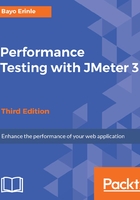
Installation
JMeter comes as a bundled archive, so it is super easy to get started with it. Those working in corporate environments behind a firewall or machines with non-admin privileges appreciate this more. To get started, grab the latest binary release by pointing your browser to http://jmeter.apache.org/download_jmeter.cgi. At the time of writing this, the current release version is 3.1. The download site offers the bundle as both a .zip file and a .tgz file. In this book, we go with the .zip file option, but feel free to download the .tgz file if that's your preferred way of grabbing archives.
Once downloaded, extract the archive to a location of your choice. Throughout this book, the location you extracted the archive to will be referred to as JMETER_HOME.
Provided you have a JDK/JRE correctly installed and a JAVA_HOME environment variable set, you are all set and ready to run!
The following screenshot shows a trimmed down directory structure of a vanilla JMeter install:

The following are some of the folders in Apache-JMeter-3.2, as shown in the preceding screenshot:
- bin: This folder contains executable scripts to run and perform other operations in JMeter
- docs: This folder contains a well-documented user guide
- extras: This folder contains miscellaneous items, including
samples illustrating the usage of the Apache Ant build tool
(http://ant.apache.org/) with JMeter, and bean shell scripting - lib: This folder contains utility JAR files needed by JMeter (you may add additional JARs here to use from within JMeter; we will cover this in detail later)
- printable_docs: This is the printable documentation